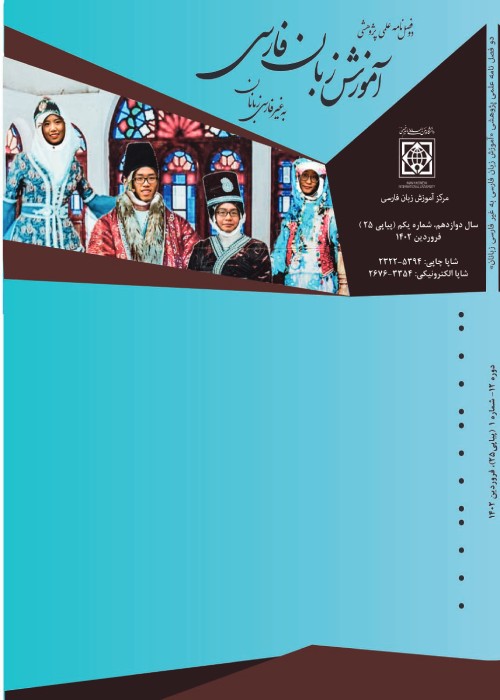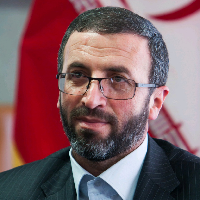Investigating the motivation level and the orientations of Turkish-speaking learners of Persian
Author(s):
Article Type:
Research/Original Article (دارای رتبه معتبر)
Abstract:
According to some scholars, many of the factors involved in the process of second language learning play their role through an affective factor called ‘motivation’. Hence, being aware of language learners’ motivation can help second language teaching planners take more effective steps toward increasing the quality of second language teaching. The present study aimed to explore the motivation level and the orientations of Turkish-speaking students of Persian language and literature at Ankara University. The research sample included 80 BA students of Persian language and literature at Ankara University. For data collection, a questionnaire drawn from Gardner’s (1985b) attitude/motivation questionnaire was distributed among the subjects. The questionnaire investigated the learners’ ‘attitudes toward language learning’, ‘motivational intensity’, ‘desire’, and ‘orientation’. The collected data were analyzed using the descriptive statistics indices. The results showed above the mean positive attitudes (36 out of 40), above the mean motivational intensity (22 out of 24), and a very strong desire (19.25 out of 21) for learning Persian among the subjects. The sum of the three scores(male subjects= 75.20 out of 85, female subjects= 79.30 out of 85) indicated the subjects’ high level of motivation for learning Persian. In terms of the subjects’ orientations, the results showed that 77.5% of the subjects (females= 83%, males= 72%) adopted an integrative orientation and the rest of the subjects, i.e. 22.5% (females= 17%, males= 28%) adopted an instrumental orientation toward learning Persian language. Expanded Abstract Motivation is one of the most important factors which plays a key role in the process of second language learning. According to some scholars, many of the factors involved in the mentioned process play their parts via the emotional factor of ‘motivation’. It is noteworthy that ‘motivation’ is not a simple construct. In his ‘socio-educational model of second language acquisition’, Gardner (1985a) argues that motivation involves the following four aspects: a goal, effortless behavior, a desire to attain the goal, and favorable attitudes toward the activity in question. Gardner (ibid.) has grouped these four aspects into two conceptually distinct categories: (1) the goal and (2) the other three aspects. This grouping is based on the belief that although the goal is a stimulus giving rise to motivation, individual differences in motivation itself are reflected in the other three aspects, i.e. effort expended to achieve the goal, desire to achieve the goal, and attitudes toward the activity involved in achieving the goal. Accordingly, with regard to second language learning, it can be argued that motivation is a combination of effort, desire to learn the second language, and favorable attitudes toward learning the second language. According to Gardner (ibid.), in assessing motivation to learn a language, the three aspects listed above are reflected in the measures motivational intensity, desire to learn the language, and attitudes toward learning the language, respectively. The distinct aspect, i.e. the goal, is reflected in the individual’s orientation to language study. Drawing on Gardner’s (1985a) theory, the present research strived to explore the motivation level and the orientations of Turkish-speaking students of Persian language and literature at Ankara University. The research sample included 80 BA students of Persian language and literature at Ankara University. In order to gather the data needed for analysis, a questionnaire taken from Gardner’s (1985b) attitude/motivation questionnaire was distributed among the subjects. The questionnaire contained tests of ‘attitudes toward language learning’, ‘motivational intensity’, ‘desire’, and ‘orientations’. The first three tests listed above were designed to measure the subjects’ motivation level. The attitude scale contained 8 statements (4 positive and 4 negative statements). These statements appeared on a Likert scale which had five alternatives. The motivational intensity scale contained 8 three-choice statements and measured the amount of effort which the language learners expended on learning Persian language. The highest mark for each statement was 3 and the lowest mark was 1. Hence, the highest mark for the motivational intensity was 24. The desire scale had 7 three-choice statements which measured the subjects’ desire to learn Persian language. The highest mark for each statement was 3 and the lowest mark was 1. Hence, the highest mark for the desire was 21. Finally, the orientation scale contained only 1 four-choice statement. Two choices measured instrumental orientation and the other two choices measured integrative orientation. To calculate the reliability of the three motivation scales and the orientation scale for Persian language learning, the internal consistency method was utilized (Cronbach's alpha test). The Cronbach’s alpha reliability coefficients were above 0.70 for all the scales, indicating that the scales were reliable. The results showed above the mean positive attitudes (36 out of 40), above the mean motivational intensity (22 out of 24), and a very strong desire (19.25 out of 21) for learning Persian among the subjects. The sum of the three scores(male subjects= 75.20 out of 85, female subjects= 79.30 out of 85) indicated the subjects’ high level of motivation for learning Persian. In terms of the subjects’ orientation or motivation type, it turned out that 77.5% of the subjects (females= 83%, males= 72%) possessed an integrative orientation and the rest of the subjects, i.e. 22.5% (females= 17%, males= 28%) had an instrumental orientation toward learning Persian language. In this research, the subjects who had very high motivations and adopted integrative orientation toward learning Persian language often sought information about the Persian-speaking community and its cultural values, expanded their communication through interaction with the community, and got closer to that community. This could be a very good ground to promote Persian language in Turkey. Indeed, the deep religious, cultural, and literary links between the two countries of Iran and Turkey on the one hand and the emotional readiness of the Turkish-speaking learners of Persian on the other hand provide a suitable platform for the better promotion of the Persian language and culture among Turkish-speaking learners of Persian in Turkey.
Keywords:
Language:
Persian
Published:
Journal of Teaching Persian to Speakers of Other Languages, Volume:7 Issue: 16, 2018
Pages:
3 to 22
magiran.com/p2043479
دانلود و مطالعه متن این مقاله با یکی از روشهای زیر امکان پذیر است:
اشتراک شخصی
با عضویت و پرداخت آنلاین حق اشتراک یکساله به مبلغ 1,390,000ريال میتوانید 70 عنوان مطلب دانلود کنید!
اشتراک سازمانی
به کتابخانه دانشگاه یا محل کار خود پیشنهاد کنید تا اشتراک سازمانی این پایگاه را برای دسترسی نامحدود همه کاربران به متن مطالب تهیه نمایند!
توجه!
- حق عضویت دریافتی صرف حمایت از نشریات عضو و نگهداری، تکمیل و توسعه مگیران میشود.
- پرداخت حق اشتراک و دانلود مقالات اجازه بازنشر آن در سایر رسانههای چاپی و دیجیتال را به کاربر نمیدهد.
In order to view content subscription is required
Personal subscription
Subscribe magiran.com for 70 € euros via PayPal and download 70 articles during a year.
Organization subscription
Please contact us to subscribe your university or library for unlimited access!



